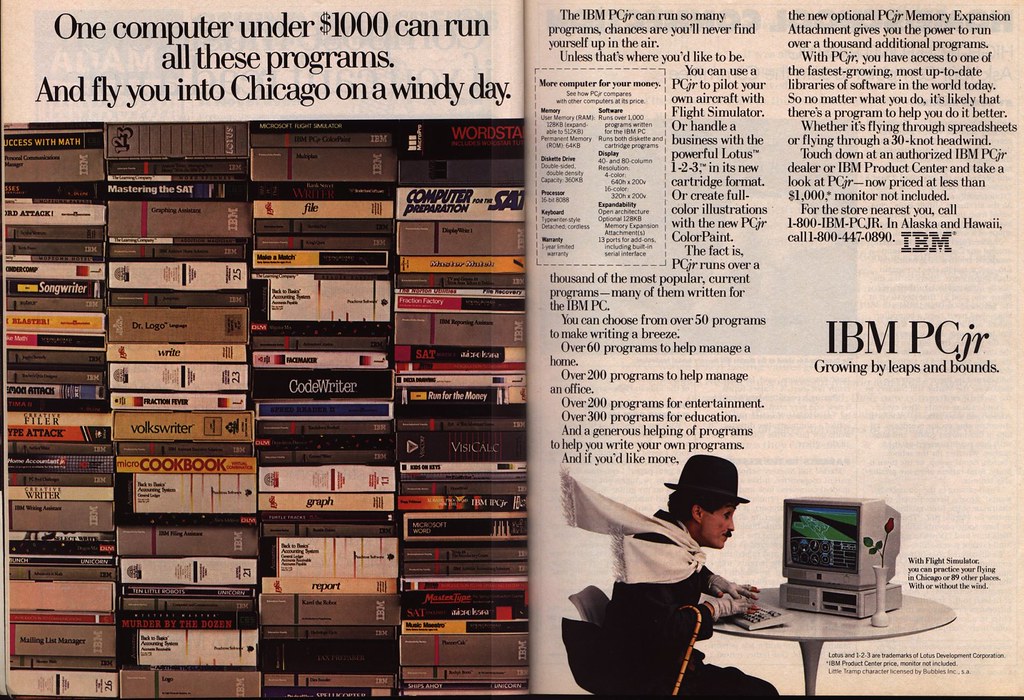On the other hand, there have been lots of computers sold with much more serious problems -- laptops with exploding batteries, untrustworthy hard drives, defective motherboard capacitors, computers that had to be dropped periodically, and awful quality drivers, not to mention this infamous scam.
All of this makes the maligned Zenith Eazy PC look pretty good. But this got me thinking: what is the worst computer of all time? Everyone loves a good train wreck -- so if you disagree, please submit your own. But my money is on the IBM PCJr.
 |
| Cropped from Marcin Wichary's photo (Some Rights Reserved) |
The IBM PCJr shipped in 1984, when IBM PC was already popular in the business world but much cheaper computers like the Commodore 64 were reigning champs in the new home computer marketplace.
The Commodore 64 and its Atari and Timex ilk were very simple computers built into a chassis along with the keyboard. Everything else was sold separately -- disk drives were extra, and you generally plugged them into your existing television. It was up to the software developers to take these very simple computers and do something exciting with them, setting up a "wild west" of software development where a talented hothead could really compete with a big company.
Speaking of big companies -- back to IBM.
 |
| Photo courtesy of MooOnThePasture, Some Rights Reserved |
They left out the PC's Direct Memory Access (DMA) support, meaning that peripherals (notably the floppy drive) weren't able to work autonomously while the rest of the computer did something else; apparently the keyboard wouldn't work while the floppy drive was being accessed.
They torpedoed the expansion options by leaving out a standard IBM PC slot; instead, customers were supposed to attach a "sidecar". This is pretty similar to the Zenith Eazy PC, actually, and I don't like it here either. They limited RAM upgrades severely and a number of technical details kept the performance well below a similarly-spec'd PC.
But what people remember most about the IBM PCJr is probably its awful keyboard. At first, it came with the so-called "Chiclet" keyboard, a nearly impossible-to-use travesty from a company known for legendary keyboards. Worse still, it was wireless, linked by infrared. I never had the misfortune of using this keyboard but I can certainly imagine the experience. IBM quickly changed the design when even the most positive reviews gave it a less-than-glowing recommendation.
It was too expensive for a toy and not serious enough for a computer. It flopped famously and IBM canned it after just a few short years.
Clearly some people bravely loved even this computer. Not me -- my only experience with it came in 1994 or so when I found one at a Value Village, brought it home, and opened it up. I remember being disgusted to pop it open and discover that it had no soul inside, the way an IBM PC or Compaq Portable or Apple II did.
Tandy cloned the PCJr as the Tandy 1000 -- anyone playing Sierra games in the late 1980s will remember being able to select Tandy 1000 for audio support or the TGA (Tandy Graphics Adapter) for video support. These were actually PCJr peripherals, but because the PCJr was so short-lived (the Tandy 1000 came to market only slightly before IBM canned the PCJr line) companies shipped software naming the Tandy instead of its short-lived PCJr father. The Tandy had some of the same flaws as the PCJr, but they got enough right -- a usable keyboard and a few IBM PC expansion slots -- that it doesn't stir up the same level of revulsion.
So, did anyone use one of these? Mine met a rapid end in the knee-deep sludge of dismantled electronics that was my childhood basement. And a good riddance too.
I had one, when I was a young lad. Picked it up to go into my mess of other random PC's in the late 80's, and was pissed off because despite claiming to be "compatible" it really wasn't... and was, in fact, pretty much entirely useless. Mine was definitely dismantled and largely scrapped as being unusable.
ReplyDeleteI never did use a Tandy1000, and had no idea that the Tandy hardware was the same hardware as the PCJr - nifty tidbit!
Yeah, if history's an accurate judge Tandy managed to make lemonade out of a lemon. The Tandy 1000 line went on successfully for years. I guess they learned some lessons from the earlier Tandy 2000, which was a failed "compatible".
ReplyDeleteStill, back in the 80's my PC friends tended to drool when they saw my PCjr with it's 16 colors and 3-voice sound and music play games that were less than impressive on their computers, which could display only 4 colors and could play only 1 sound or note at a time (they had to wait for EGA and Sound Blaster cards to equal the Jr's abilities). This little computer was very well supported for at least another decade after IBM dropped it so it had a huge user base. I still have my Jr and it still works, although it's primarily a dust collector alongside my Tandy 100 and 1000, IBM Portable Computer, and IBM Convertible (IBM's first laptop). I doubt most computers that people use today won't still be running when they're 30 years old!
ReplyDelete